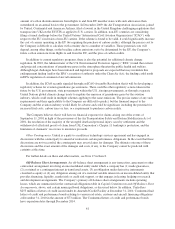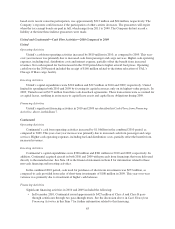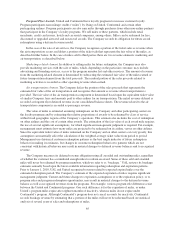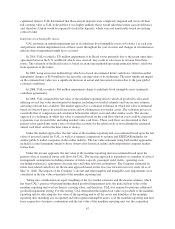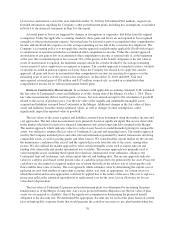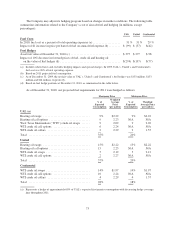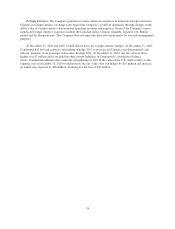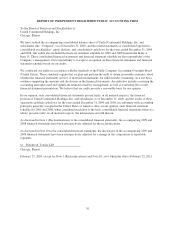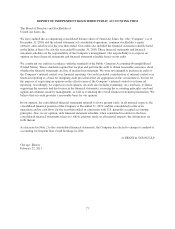United Airlines 2010 Annual Report Download - page 69
Download and view the complete annual report
Please find page 69 of the 2010 United Airlines annual report below. You can navigate through the pages in the report by either clicking on the pages listed below, or by using the keyword search tool below to find specific information within the annual report.capitalized interest. UAL determined that these aircraft deposits were completely impaired and wrote off their
full carrying value as UAL believed that it was highly unlikely that it would take these future aircraft deliveries
and, therefore, United would be required to forfeit the deposits, which were not transferable based on existing
contract terms.
Indefinite-lived Intangible Assets
UAL performs an annual impairment test of its indefinite-lived intangible assets on October 1 of each year
and performs interim impairment tests of these assets throughout the year if events and changes in circumstances
indicate that an impairment might have occurred.
In 2010, UAL recorded a $29 million impairment of its Brazil routes primarily due to the recent open skies
agreement between the U.S. and Brazil which, once enacted, may result in a decrease in revenue from these
routes. The valuation of the Brazil routes is based on an income methodology using estimated future cash flows
from operation of the routes.
In 2009, using an income methodology which was based on estimated future cash flows, United recorded
impairment charges of $150 million to decrease the carrying value of its tradename. The most significant impact
on the estimated fair value was a significant decrease in actual and forecasted revenues due to the poor global
economic conditions.
In 2008, UAL recorded a $64 million impairment charge to indefinite-lived intangible assets (primarily
codeshare agreements).
In 2008, UAL estimated the fair value of the mainline reporting unit (to which all goodwill is allocated)
utilizing several fair value measurement techniques, including two market estimates and one income estimate,
and using relevant data available. The market approach is a valuation technique in which fair value is estimated
based on observed prices in actual transactions and on asking prices for similar assets. The valuation process is
essentially that of comparison and correlation between the subject asset and other similar assets. The income
approach is a technique in which fair value is estimated based on the cash flows that an asset could be expected
to generate over its useful life, including residual value cash flows. These cash flows are discounted to their
present value equivalents using a rate of return that accounts for the relative risk of not realizing the estimated
annual cash flows and for the time value of money.
Under the market approaches, the fair value of the mainline reporting unit was estimated based upon the fair
value of invested capital for UAL, as well as a separate comparison to revenue and EBITDAR multiples for
similar publicly traded companies in the airline industry. The fair value estimates using both market approaches
included a control premium similar to those observed for historical airline and transportation company market
transactions.
Under the income approach, the fair value of the mainline reporting unit was estimated based upon the
present value of estimated future cash flows for UAL. The income approach is dependent on a number of critical
management assumptions including estimates of future capacity, passenger yield, traffic, operating costs
(including fuel prices), appropriate discount rates and other relevant assumptions. The Company estimated its
future fuel-related cash flows for the income approach based on the five-year forward curve for crude oil as of
May 31, 2008. The impacts of the Company’s aircraft and other tangible and intangible asset impairments were
considered in the fair value estimation of the mainline reporting unit.
Taking into consideration an equal weighting of the two market estimates and the income estimate, which
has been UAL’s practice when performing annual goodwill impairment tests, the indicated fair value of the
mainline reporting unit was less than its carrying value, and therefore, UAL was required to perform additional
goodwill impairment testing. For this testing, UAL determined the implied fair value of goodwill of the mainline
reporting unit by allocating the fair value of the reporting unit to all the assets and liabilities of the mainline
reporting unit, including any recognized and unrecognized intangible assets, as if the mainline reporting unit had
been acquired in a business combination and the fair value of the mainline reporting unit was the acquisition
67






